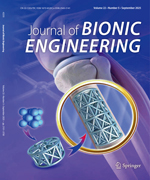|
|
Shock-Resistant and Energy-Absorbing Properties of Bionic NiTi Lattice Structure Manufactured by SLM
Zhenglei Yu, Renlong Xin, Zezhou Xu, Luming Sha, Lixin Chen, Yining Zhu, Ping Liang, Zhihui Zhang, Zhenze Liu & Qing Cao
Journal of Bionic Engineering. 2022, 19 (6):
1684-1698.
DOI: 10.1007/s42235-022-00221-0
Each specific structure of organisms is the best choice under specific circumstances. The excellent characteristic structures of these organisms have great application potential in the design and multi-functional optimization of energy-absorbing structures such as vehicle collisions, satellite landings, and military equipment. In this paper, using the principle of structural bionics, using the advantages of the honeycomb structure and the light weight and high strength of beetle elytra, four bionic lattice structures are studied: CH, ZPRH, SCH and IBE. Using NiTi shape memory alloy, a unique material as the base material, samples are prepared using selective laser melting (SLM) technology. By comparing the test results of the quasi-static compression test with the results of the numerical simulation, it is found that compared with the other three bionic lattice structures, the SCH structure has the best energy absorption effect in the effective stroke in the test, and the specific energy absorption can reach 6.32 J/g. ZPRH, SCH, and IBE structures not only have good and stable deformation behavior, but also have excellent impact resistance and shape memory properties. The design of these structures provides a reference for the design of anti-shock cushioning structures with self-recovery functions in the future.
Related Articles |
Metrics
|

 Table of Content
Table of Content
 Table of Content
Table of Content